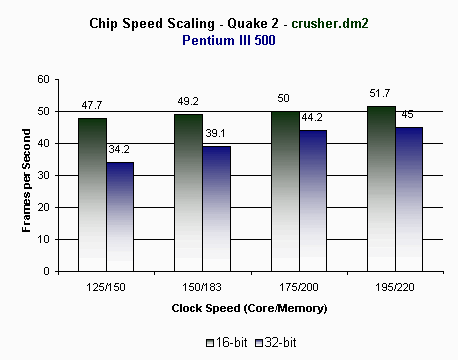OpenGL Performance
Quake 2 is on its way out as a benchmark, but concluding its reign with a bang is the Dynamite TNT2 Ultra at the overclocked 195/220MHz setting as it dominates the high-end system scores at 1024 x 768. The Dynamite TNT2 Ultra benchmarked flawlessly at all speeds, unfortunately, even the 195/220MHz monster takes a back seat to the Matrox G400 in terms of performance when rendering in 32-bit color. Do keep in mind that the high performing G400MAX still has yet to hit the streets and when it does (most likely in July) it will come with a not-so-friendly $250+ price tag.

There's no major change in the crusher arena, the Dynamite TNT2 Ultra at 195/220 still dominates the charts. The 16MB Leadtek TNT2 moves up slightly simply due to more aggressive memory timings on the Leadtek card, which is clocked at a much lower frequency by default than Hercules' solution. At 200MHz, Hercules was essentially required to use slower memory timings to ensure stability during normal operation - hope I didn't give away Hercules' little secret ;)

As you can tell by the Chip Speed Scalability graphs, there is a noticeable improvement (10 fps) in the jump from NVIDIA's recommended 150/183MHz setting and the default 175/200MHz setting of the Dynamite TNT2 Ultra. The jump from 175/200 to 195/220 isn't as dramatic, but if it'll work for you go ahead and give it a try, if it doesn't, 175/200 isn't bad at all. The key point to remember here is that Hercules is guaranteeing the Dynamite TNT2 Ultra at 175/200, something no other manufacturer has done as of yet, meaning that you can expect 175/200 performance out of the box without having to worry about whether or not your card will overclock to that speed.












0 Comments
View All Comments